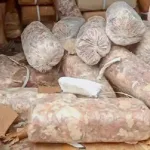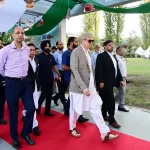Employment in the manufacturing sector has declined by 46% (CEDA-CMIE, 2021). Here, manufacturing firms are reported of two extreme kinds: small (6-49 workers) and large firms (500+ employees) (Economic and Political Weekly, 2022). Additionally, in 2019, IMF and Asian Development Bank noted that the share of the industrial sector in GDP has shrunk to its lowest in the last 20 years. The underutilization of India’s manufacturing potential led to initiatives like the National Manufacturing Policy and a thrust towards Industry 4.0. The government aims to increase industrial contributions to GDP by 25% through policies, initiatives and programs such as ‘Make in India’. According to the Indian Brand Equity Foundation (IBEF), capacity utilization in the manufacturing sector has increased by 10% in the financial year 2022.
In 2023 the underlying growth areas for future developments in FY23 may include a focus on increasing the combined index (currently, 142.8 (IBEF)) for 8 crore Indian industries. Second, an increase in exports of 10 major commodities – gems and jewellery, electronic goods, plastic and linoleum, petroleum products, drugs and pharmaceuticals, RMG of all textiles, engineering goods, organic and inorganic chemicals, cotton year or fabrics and rice. However, the manufacturing industry is characterized by underemployment, increasing attrition, gender pay gap and the gender gap which may curb this growth.
A fatal flaw of this sector is the under-representation of women. According to studies, only 12% of women constitute the workforce of this sector. Several reasons are cited for this, the myths about the manufacturing industry being labour-intensive or outdated information on improvements in technology and operations. The women’s self-help groups have shown tremendous growth. They have been dedicated to improving the quality of life, abetting poverty, and gender sensitisation among others. However, the focus has been on rural women and developing a “political network” in some states. Due to these flaws, there is a lot of untapped potential in the manufacturing sector in terms of the labour force.
India possesses the solutions to this major challenge however, the implementation seems ineffective. First, National Education Policy aims at vocational training for increasing employment. Both rural and urban women can be mentored regarding the changing opportunities in the manufacturing sector. Second, the Ministry of Labour and Employment focuses on the need for building an all-inclusive workplace and developing policies such as flexible work, paternity and maternity leaves, and health and safety which can be incorporated into this sector. Third, the companies that emphasize women’s role in manufacturing can be recognized under the National Manufacturing Policy or Make in India. For instance, Tata Steel hired 38 women heavy machinery operators at their mines in West Bokaro and Noaumundi under their well-appreciated programme ‘Women@Mines’.
In another instance, Daimler India Commercial Vehicles hired 46 women in Chennai in truck and bus manufacturing under their “inclusion and diversity” plan. In Tamil Nadu, 10,000 women were hired in two-wheeler manufacturing by Ola Electric. Hindustan Coco-Cola Beverages aims to incorporate a 6:4 workforce where women account for 60% of its factory in Siliguri. Fourth, only 22.3% of women are a part of the Indian labour force.
There are a plethora of schemes such as Udyogini, Annapurna, Mudra Yojana, and Stand Up India. However, their effectiveness can be evaluated only on grounds of increasing opportunities for women. Efforts have been directed towards rural women through self-help groups, however, the ethicality of intentions is still under debate. Nevertheless, urban women who require finances for entrepreneurial objectives through micro-finance systems and micro-loans or career development guidance should be leveraged. India should reflect and mirror their own SHGs initiatives of the 1980s where programs such as the Self Help Group Bank Lineage Programme connected members of the group with sustainable financial services.
Internationally countries popularize programs such as ‘Women MAKE America’ to close the gender gap in manufacturing. The program intends to create role models to inspire the next generation through research, leadership and training. The Canadian Manufacturers and Exporters launched an initiative through its action plan ‘Untapped Potential’ to encourage young women, change the perceptions and gender myths in manufacturing, and encourage skills training and adoption of an inclusive workforce. The International Center for Research for Research and Women published an article on gender and inclusion in Kenya (Mugyenyi et al., 2020) which highlight the need to implement and integrate policies that are scattered. Although India has several policies laid down for human resources and women’s development, there is a huge gap in the incorporation and parallel alignment of the policies/programmes/plans for optimal results.
A deliberate effort should be made to review the National Education Policy, National Manufacturing Policy, Make in India, Laws by the Ministry of Labour and Employment, and women’s self-help groups through a gendered lens and create guidelines inclusive of gender if required. Self-help groups can function simultaneously depending on the needs of both rural and urban women. Central regulations are required on the selfish and unethical interests of political parties who use self-help groups to fulfilling their research agendas.
The above figure shows the sustainable parallel universe model for policies, action plans, programmes/initiatives, regulatory laws, gender-neutral workforce and public/private firms. This parallelly running policies/programmes/action plans/initiatives can be drawn upon with the inclusion of women. The parallel universe model helps to illustrate a sustainable perspective for the future of women, policies and growth in the manufacturing sector. All the elements of this parallelism create a wholesome implementation of government agendas.
(The Author is Doctoral Scholar (PhD), ICFAI Business School IBS, Hyderabad)





